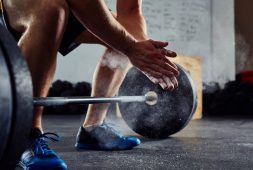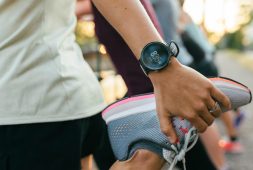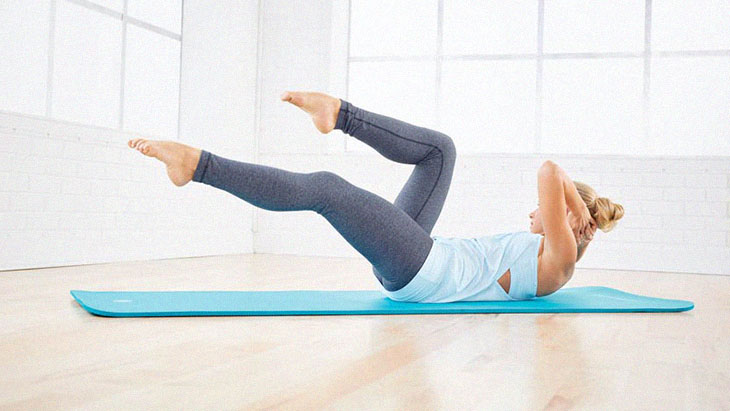
Do you suffer from lower back pain and no matter what you do, the pain never truly goes away? You’re not alone. Studies show that at least 80% of Americans suffer from lower back pain at some point in their lives. Statistics also share that it is the 3rd most common reason that people go to the doctor and the 2nd leading cause for individuals to miss work. In fact, the only cause that beats it is the common cold!
There is quite a long list when it comes to what causes back pain. More serious reasons include sprains and strains, fractures and herniated discs. But there are also simpler triggers that people don’t even realize like poor posture, slouching while working or at a seated desk, caring for a baby, or carrying around a purse that’s too heavy.
While there are a number of over-the-counter medications and possible surgeries that can help alleviate the problems, these aren’t always the best solutions. In fact, more often than not, exercise is the most effective tool you can use against back pain. But while some exercises can help, it’s actually Pilates that can be the best way to finally stop your back pain for good.
Thankfully, there are many ways that you can do Pilates – whether it’s taking a class or practicing in the comforts of your own home – that can help you lessen back pain, and even prevent it. According to mayoclinic.com, Pilates, which is a method of exercise, “emphasizes proper postural alignment, core strength and muscle balance.” Because of this, it focuses on ‘evidence-based rehabilitation’ in order to better treat lower back pain.
According to Amy Kiser Schemper, the creator of Prevention’s new 10-minute Pilates workout program, “Pilates offers so many options to access your core muscles for all different fitness levels, ages, and body types.”
By combining deep breathing with short and precise movements, this will help strengthen the deep abdominal and back muscles to lessen back pain overall. Here are 4 Pilates exercises that you can try to not only target various parts of your core, but to help relieve back pain.
1. SWIMMERS
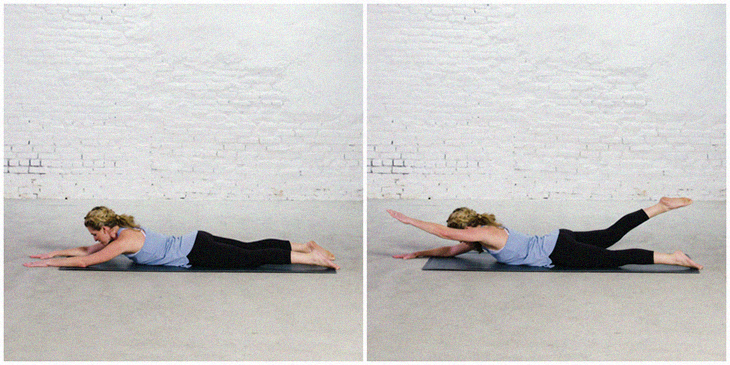
Here’s how you do them: First lie down on your stomach with your arms extended forward, and lift your head and neck off the floor. At the same time, lift the opposite arm with the opposite leg and hold it for a moment. Go back to the starting position and repeat on the other side.
What they target: With every twist, tilt or arch of your back, you target your multifidus. These are a series of tiny muscles attached to your spinal column that stabilize your vertebrae. This exercise keeps them strong and limber.
How they help: Since Swimmers are moves that start in a stomach-down position, it activates and fires up the multifidus, which in turn supports the spine better.
2. PLANK SINGLES
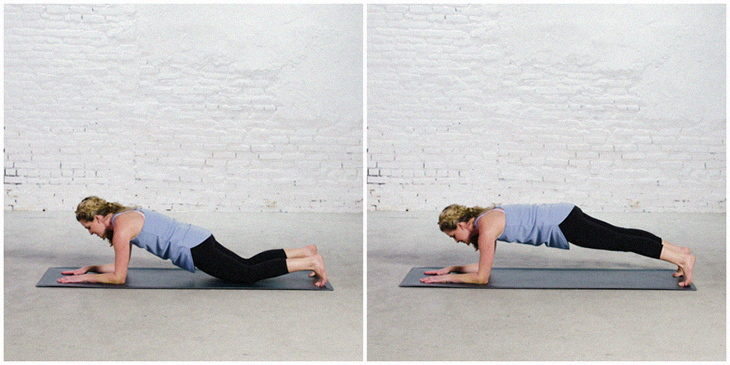
Here’s how you do them: Start on your stomach and prop your upper body onto your forearms with your toes pressing into the mat, as seen in the first photo above. Pull our abs in tightly, using your core to push your knees up and off the ground, forming a forearm plank position. Reverse this move, again using your abs to control your knees as you bring them back down to the mat then on your stomach once again in the starting position.
What they target: The transversus abdominals (TVA) are the deepest of the abdominal muscles, which wrap around your lower abdomen horizontally. These keep the internal organs in place, as well as support the spine. Unlike the more noticeable obliques and upper abs, a sculpted TVA won’t necessarily change the way your waistline looks, but they certainly help improve the way your lower back feels.
How they help: By practicing plank variations like plank singles, they lower any strain the back may feel by demanding that your deep core muscles do all the work.
3. SHOULDER BRIDGES
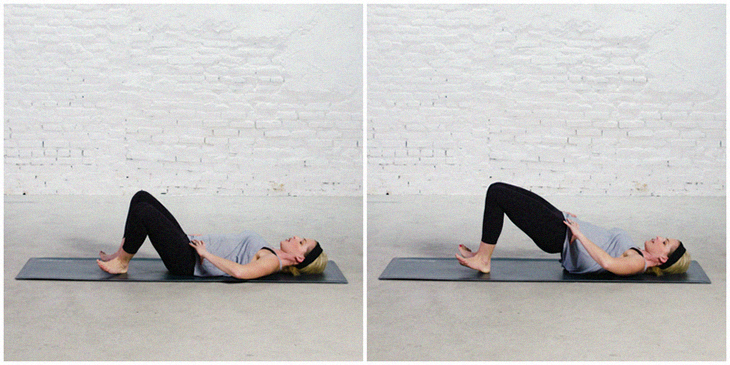
Here’s how you do them: Start by lying on your back with your knees bent and your arms resting on your thighs. Lift your butt off the ground to form a straight line from your knees down to your shoulders, as seen in the photo on the right. Be sure to keep your core tight and keep your lower back from arching, then return to starting position.
What they target: This exercise targets your Pelvic floor, which is highly important since it acts like a safety net that carries the pelvic organs – such as the bladder, uterus and bowels – which also helps stabilize the pelvis as you move about. For some women, pregnancy and age can stretch the pelvic floor out, which then lessens its ability to support these areas at full strength. Since the weak pelvic floor muscles can eventually lead to incontinence, painful sex, and back pain, these precise exercises help isolate these often-neglected muscles to strengthen them, as well as treat chronic lower back pain.
How they help: The exercise works by using gravity to remove pressure from the pelvic floor muscles while strengthening them simultaneously.
4. THE HUNDRED
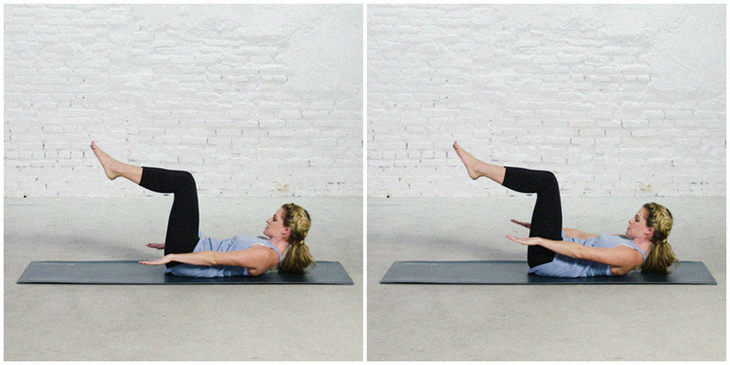
Here’s how you do them: Lie down on your back with your knees lifted up to create a 90-degree angle with your legs, and lift your head and shoulders off the mat. Be sure to press your core muscles into the mat, while pulsing your arms up and down in small increments. Start off with 50 at first, but the main goal is to do at least 100 pulses each time, hence the name.
What they target: The hundred is one of the best exercises for the diaphragm, and the diaphragm is important because your breath affects the way your muscles work, and how well they work at that. For Pilates especially, a certain way of breathing will enable the diaphragm, which in turn aids in stabilizing the muscles in your core. By using the same kind of breathing techniques during your daily physical activities, this will also help you become more mindful of the way your body moves in order to reduce the risk of back injury.
How they help: The hundred, which is considered a traditional Pilates move aids in balancing both inhales and exhales, allows your diaphragm to engage the muscles that support the spine effectively, lessening the chances of injury.
For those that believe that Pilates is just another type of physical workout, it’s actually six basic principles – centering, concentration, control, precision, breathing, and flow. Not only works on the physical aspects, but through continuous practice, it can also boost a person’s well-being. Simply focusing on your breathing already makes you more aware of your body and the way it works. Add to that the meditative quality of this practice, and you’ll see how it reduces factors that tend to aggravate anxiety and stress.With a combination of positive physical and mental responses from practicing Pilates, this is also a major reason why a number of rehabilitation centers find ways to incorporate these exercises into their programs. According to Kiser Schemper, “it’s an exercise truly anybody can do. It’s very accessible to all fitness levels and


